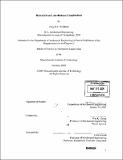Research on late-robust combustion
Author(s)
Wildman, Craig B. E. (Craig Bradley Edward), 1987-
DownloadFull printable version (5.776Mb)
Other Contributors
Massachusetts Institute of Technology. Dept. of Mechanical Engineering.
Advisor
Wai K. Cheng.
Terms of use
Metadata
Show full item recordAbstract
To better understand the role that turbulence plays in causing cycle-by-cycle variations, an experimental study was carried out in which charge motion or laminar flame speed was varied. Two sets of tests were done. The first consisted of using an air jet mounted in the intake port to generate charge motion at a spark-timing sweep from 20⁰ BTC to 200 ATC. Two jet orientations were tested with the intent of generating swirl and tumble. Also done over this spark-timing sweep, the second set of tests consisted of replacing the nitrogen in air with a diluent, argon or carbon dioxide, to increase or decrease, the laminar flame speed. Tests were conducted at fast-idle conditions. These were 2.6bar NIMEP, 1400rpm, 20⁰C average coolant temperature, and relative air-fuel ratio set to 1.00. In-cylinder pressure measurements yielded COV of NIMEP and burn duration. Exhaust temperature was also recorded. The swirl jet improved COV of NIMEP a maximum of approximately 30% at each spark timing tested. The tumble jet improved COV a maximum of 10% to 44% depending on the spark timing. No jet flow increased or decreased exhaust temperature more than approximately 5%. Strong correlation was found between exhaust temperature and combustion phasing. The turbulence test data showed a correlation between exhaust temperature and COV as well as between COV and combustion phasing. However, the change in laminar flame speed data showed a weaker correlation in both.
Description
Thesis (S.M.)--Massachusetts Institute of Technology, Dept. of Mechanical Engineering, 2005. Includes bibliographical references (p. 56-57).
Date issued
2005Department
Massachusetts Institute of Technology. Department of Mechanical EngineeringPublisher
Massachusetts Institute of Technology
Keywords
Mechanical Engineering.